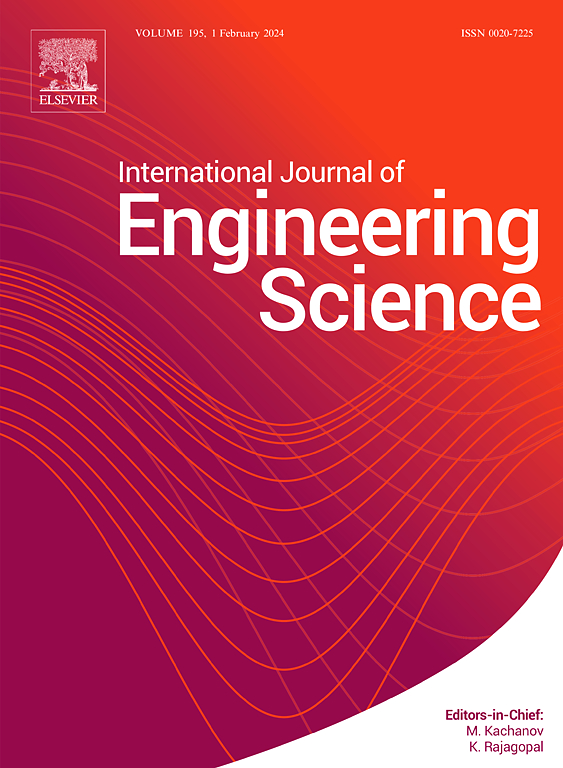脑肿瘤中纳米颗粒扩散的孔尺度分析
IF 5.7
1区 工程技术
Q1 ENGINEERING, MULTIDISCIPLINARY
International Journal of Engineering Science
Pub Date : 2025-07-03
DOI:10.1016/j.ijengsci.2025.104337
引用次数: 0
摘要
纳米颗粒已经成为一种很有前途的向脑肿瘤输送药物的平台。尽管纳米颗粒能够成功穿越血脑屏障,但其在肿瘤组织中的渗透(主要由扩散控制)仍然非常有限,这对有效递送构成了重大挑战。纳米颗粒在肿瘤组织中的扩散是由纳米颗粒与肿瘤微环境之间复杂的相互作用决定的,这一过程仍未得到充分的了解。本研究采用基于孔隙尺度的力学模型来解决这一差距。在与报道的实验结果验证后,该模型被应用于研究纳米颗粒在不同条件下在不同级别脑肿瘤中的扩散,并根据其形态学特征数学重建肿瘤微结构的三维几何形状。结果表明纳米颗粒在高级别肿瘤中扩散缓慢,尽管它们的细胞排列松散。这意味着透明质酸(肿瘤细胞外基质的关键成分)的密度在决定纳米颗粒扩散方面超过了组织孔隙度。为了量化纳米颗粒的扩散,针对脑肿瘤的每个级别,开发了经验公式来表达纳米颗粒扩散系数与透明质酸浓度以及纳米颗粒大小和zeta电位之间的关系。此外,结果表明,爱因斯坦-斯托克斯方程可以通过缩放正常体温的值来估计不同温度下纳米粒子的扩散系数,而直接计算纳米粒子的扩散系数会导致很大的误差。开发的模型和经验公式为快速预测纳米颗粒扩散提供了有效的工具,为设计药物纳米载体以改善脑肿瘤治疗提供了见解。本文章由计算机程序翻译,如有差异,请以英文原文为准。
Pore-scale analysis of nanoparticle diffusion in brain tumours
Nanoparticles have emerged as a promising platform for drug delivery to brain tumours. Despite their ability to successfully traverse the blood–brain barrier, nanoparticle penetration in tumour tissues, primarily governed by diffusion, remains significantly limited, posing a major challenge to effective delivery. The diffusion of nanoparticles in tumour tissues is determined by complex interactions between nanoparticles and the tumour microenvironment, a process that remains insufficiently understood. This study employs a mechanics-based model at the pore-scale to address this gap. After validation with reported experimental results, the model is applied to investigate nanoparticle diffusion across different grades of brain tumours under various conditions, with the 3D geometries of tumour microstructures mathematically reconstructed based on their morphological characteristics. The results indicate nanoparticles diffuse slowly in high-grade tumours despite their loose cell arrangements. This implies that the density of hyaluronic acid, the key tumour extracellular matrix component, surpasses tissue porosity in determining nanoparticle diffusion. To quantify nanoparticle diffusion, for each grade of brain tumours empirical formulas are developed to express the relationships between nanoparticle diffusion coefficient and hyaluronic acid concentration, as well as with nanoparticle size and zeta potential. Furthermore, the results demonstrate the Einstein-Stokes equation can be used to estimate nanoparticle diffusion coefficient at different temperatures by scaling the values at normal body temperature, whereas using it to directly calculate nanoparticle diffusivity would result in substantial errors. The developed model and empirical formulas provide effective tools for rapidly predicting nanoparticle diffusion, offering insights for drug nanocarriers’ design to improve brain tumour treatment.
求助全文
通过发布文献求助,成功后即可免费获取论文全文。
去求助
来源期刊

International Journal of Engineering Science
工程技术-工程:综合
CiteScore
11.80
自引率
16.70%
发文量
86
审稿时长
45 days
期刊介绍:
The International Journal of Engineering Science is not limited to a specific aspect of science and engineering but is instead devoted to a wide range of subfields in the engineering sciences. While it encourages a broad spectrum of contribution in the engineering sciences, its core interest lies in issues concerning material modeling and response. Articles of interdisciplinary nature are particularly welcome.
The primary goal of the new editors is to maintain high quality of publications. There will be a commitment to expediting the time taken for the publication of the papers. The articles that are sent for reviews will have names of the authors deleted with a view towards enhancing the objectivity and fairness of the review process.
Articles that are devoted to the purely mathematical aspects without a discussion of the physical implications of the results or the consideration of specific examples are discouraged. Articles concerning material science should not be limited merely to a description and recording of observations but should contain theoretical or quantitative discussion of the results.
 求助内容:
求助内容: 应助结果提醒方式:
应助结果提醒方式:


